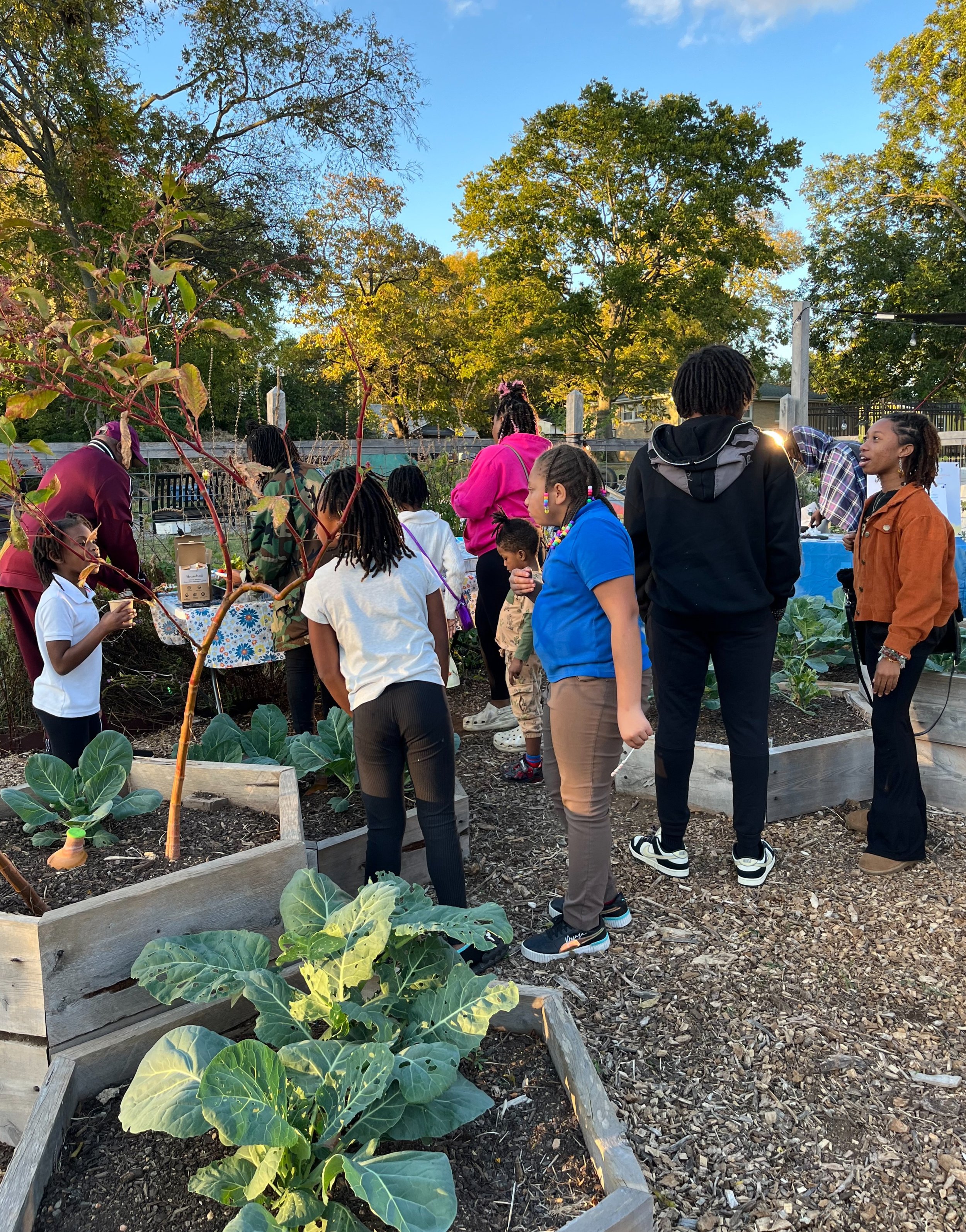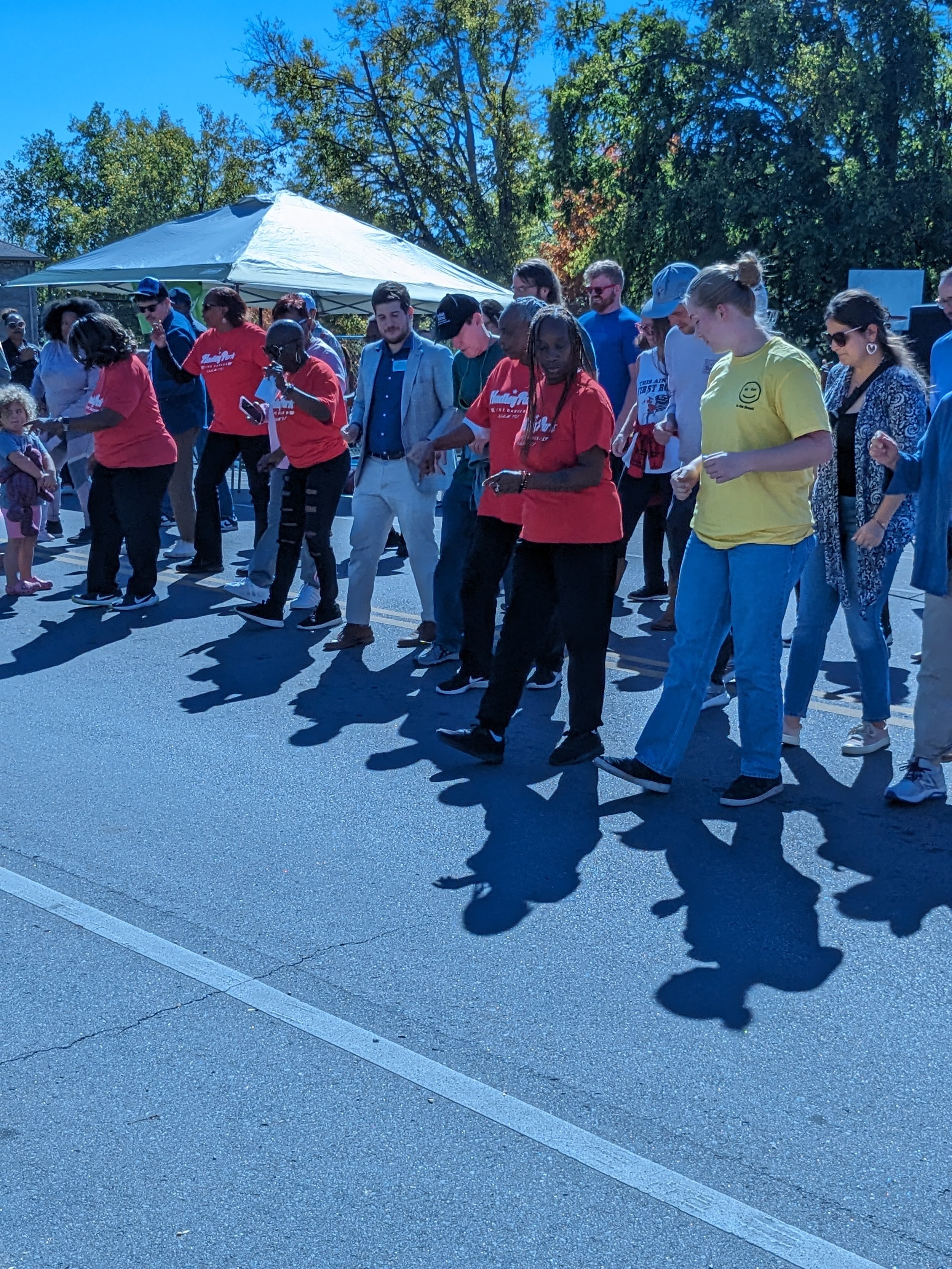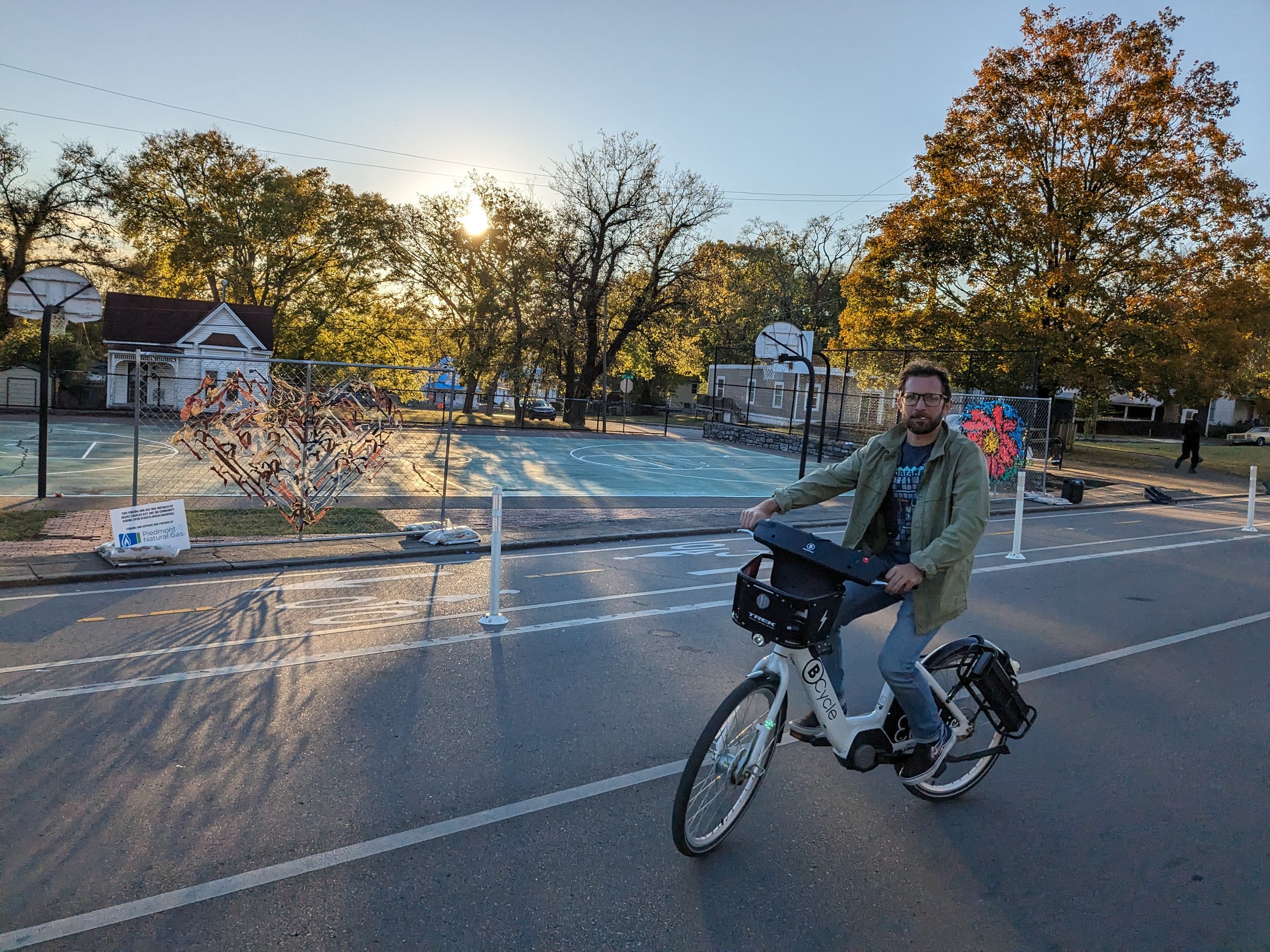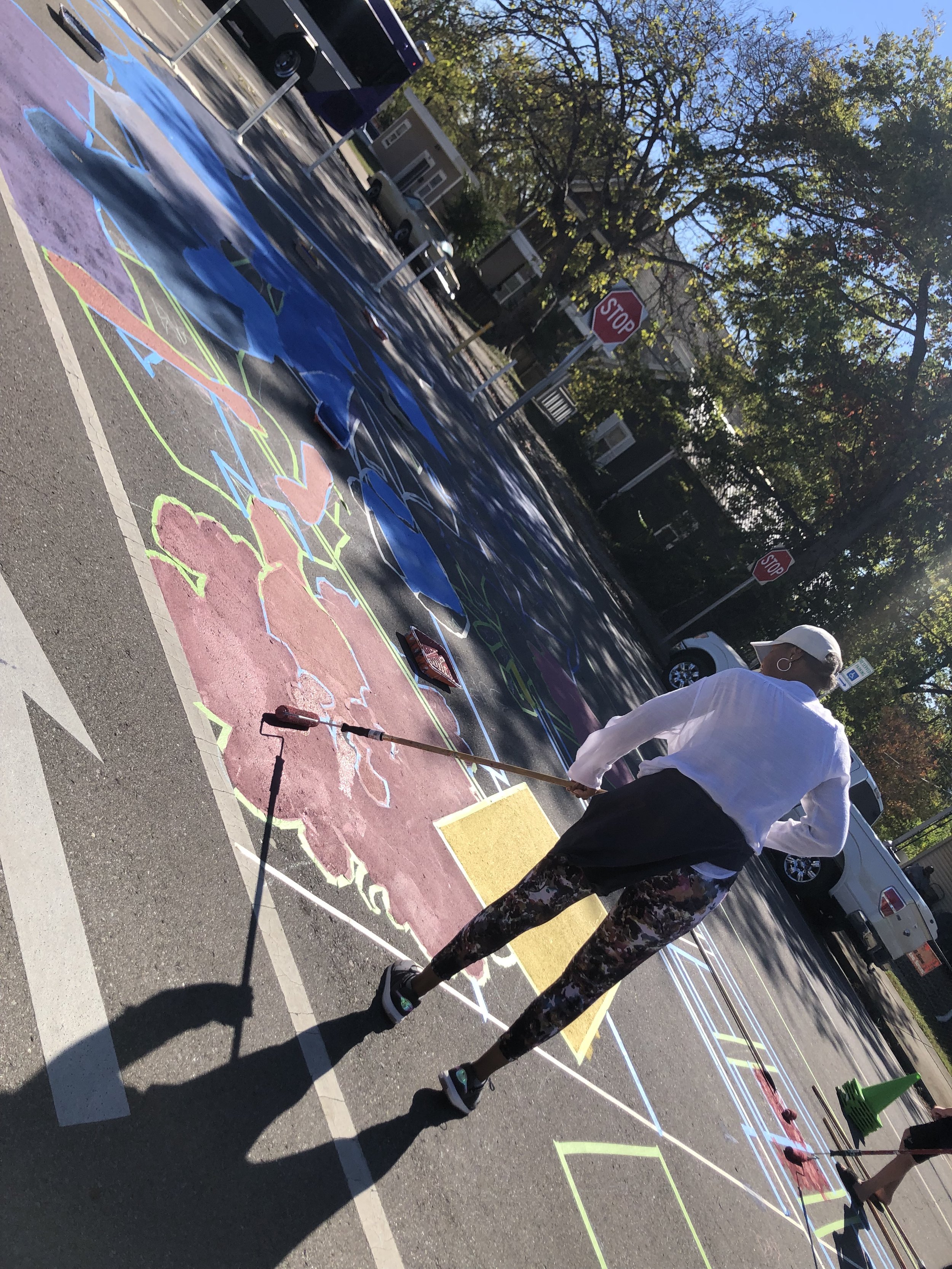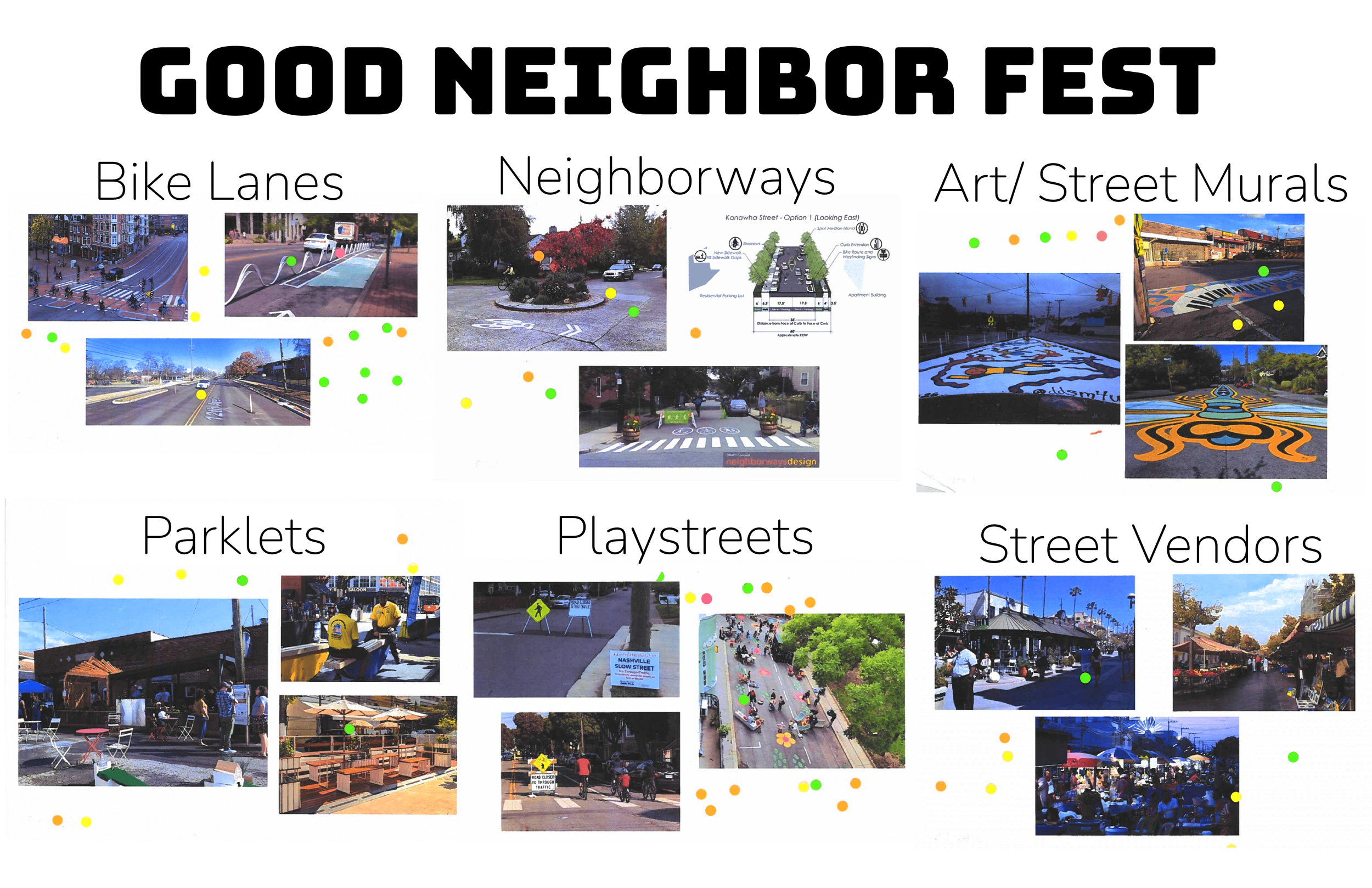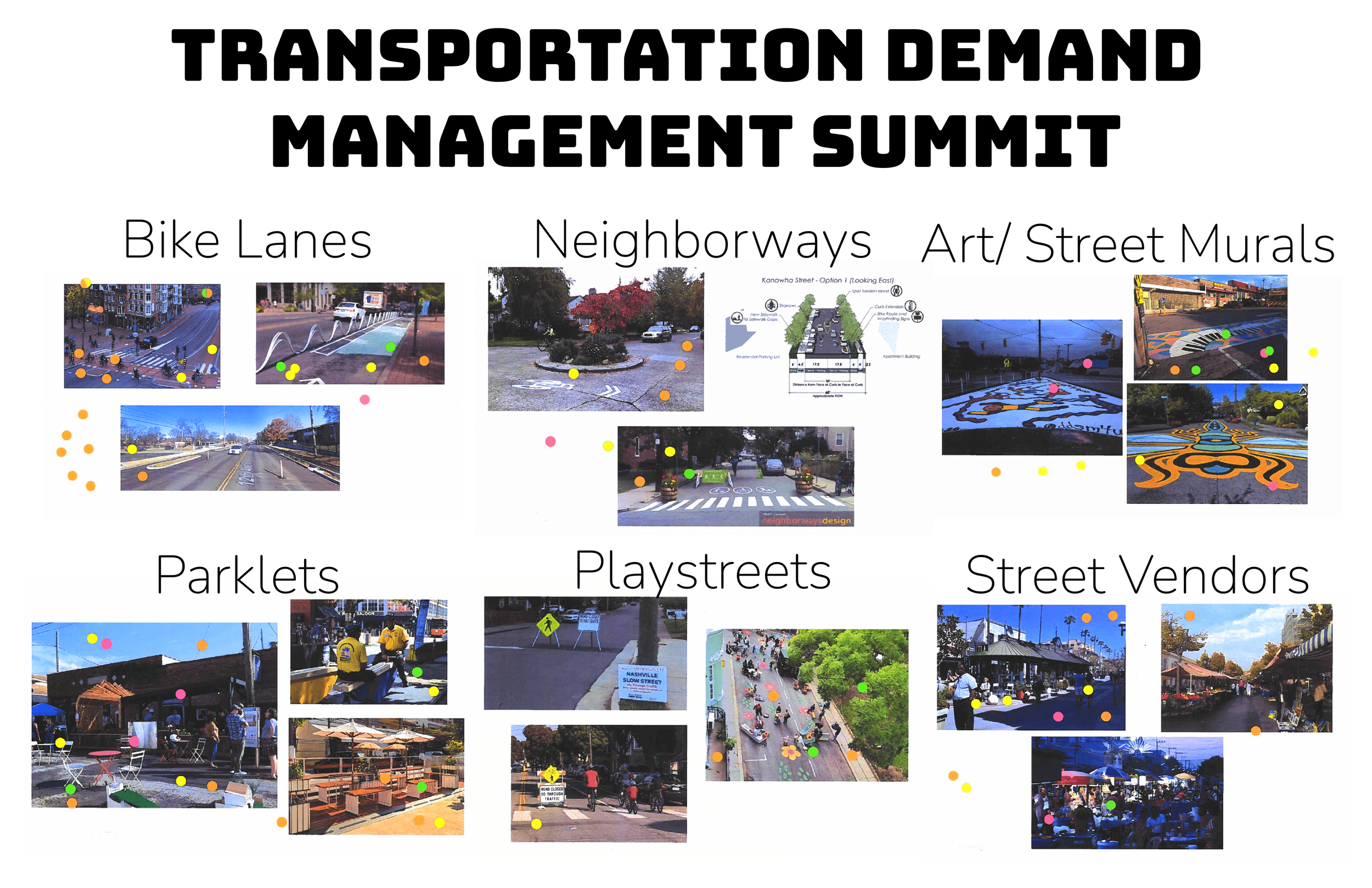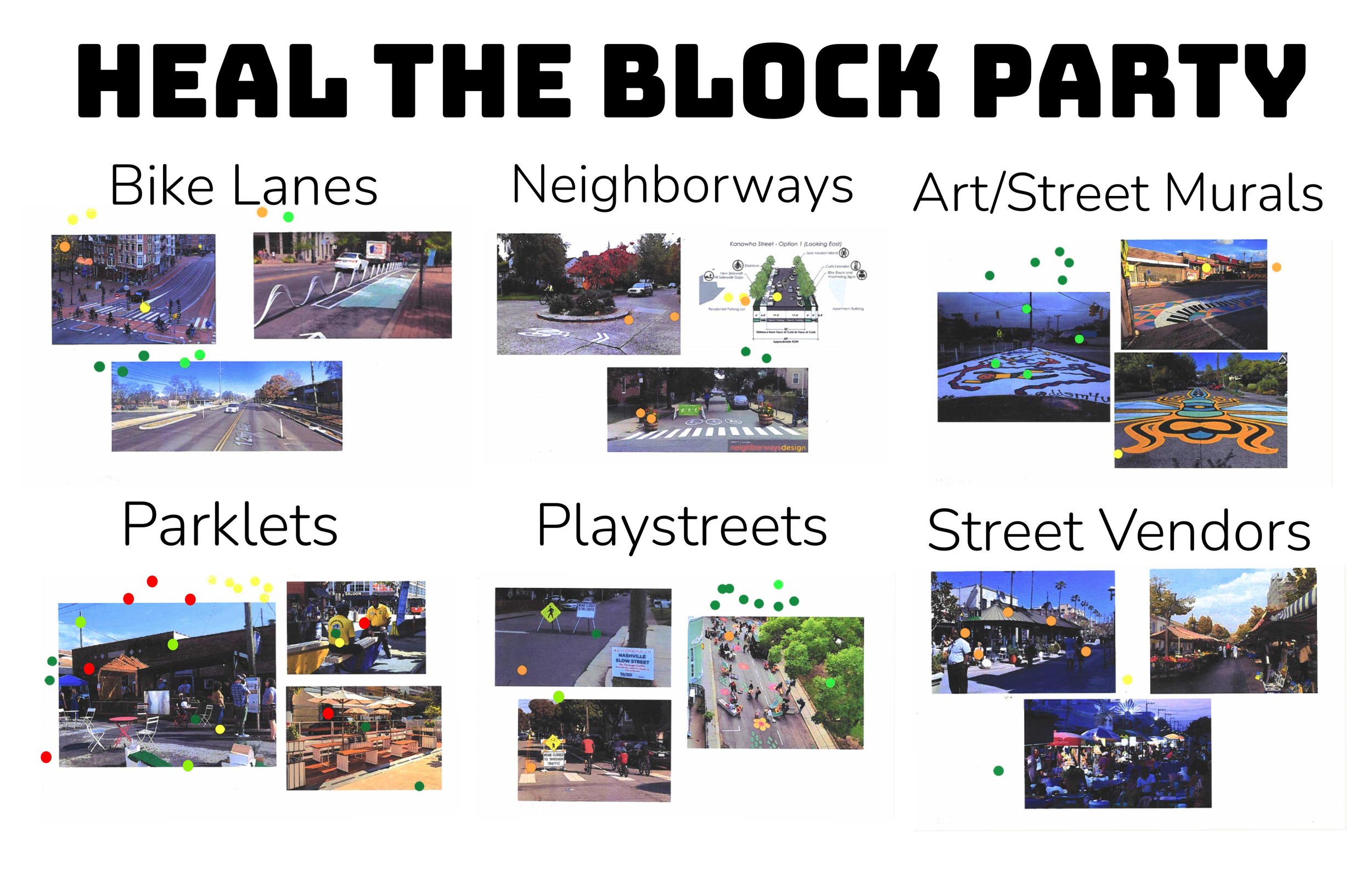Playstreets: Imagine your third space
By Nia Smith, Community Design Coordinator
6 min read Read about “playstreets,” and how they can be activated by people and neighborhoods across Nashville as places to enjoy. Metro Nashville passed an ordinance for playstreets a long time ago, and it’s time to talk about how we can bring them back into popularity as a solution for safe streets.
Local artist, Charles Key, created an art installation on fences during Open Streets, reminding us “Street is to love”
Do you ever consider how largest area of public space in Nashville is our streets? The nodes and arteries that get us through the city everyday are not just merely connections for cars—they are public infrastructure that can function for human connection as well! What if our streets could be used to address Nashville’s sidewalk shortage? Or connect greenways and parks? Reduce traffic and congestion? Help us get to know our neighbors? None of these have to be hypothetical questions. All over the world, cities are recognizing that their largest public assets can do more than just move cars around; they can serve as hubs of activity, places to exist, and even be a place to play!
Safe Slow Street Techniques
Woonerf, or a “street for living” in Dutch, is the concept that streets can be shared by cyclists and pedestrians and low speed motor vehicles.
Neighborhood road closures can allow children to have safe places to play in the street. Did you grow up in a time or place that you could play in the street as a child? Now most streets serve cars exclusively, making it too dangerous for play. Playstreets allow roads to be shut down to local traffic only and let children play in the streets again! When coupled with “neighbor ways”— local streets with slower speed limits and infrastructure for pedestrians and bikers to share the road with cars—neighborhoods can create safer places to exist on the street without a car.
It's important to remember that playstreets are not traffic calming measures. Playstreets serve to create safe streets for children to play on. Playstreets might start on a pilot, but they don’t have to be temporary, especially on streets that are already slower. COVID-era “slow streets” policy prescribed blocking the wrong side of the road to make play a priority and to slow neighborhood cars down. While “slow streets” were temporary, playstreets are not—your neighborhood can advocate for a permanent playstreet.
At the Brooklyn Heights Community Garden, youth spend time in a natural third space that allows them to feel safe together
“In a society that essentially forces us all to participate in the marketplace, our third places are mostly limited to private buildings where we have to continuously spend money to simply be there. This is inherently exclusionary to people across multiple lines of social stratification, whether it be income, physical accessibility, or lack of transportation. Open Streets offer an opportunity to democratize the creation of third places, and bring these places to the doorsteps of the people. Everyone is welcome, everyone has access.
What if we worked to design cities that moved harmoniously with nature, and rejoiced in our place within the larger ecosystem? We could extend the feeling that we get when we visit a city park or a national forest, and inject our cities with the very same appreciation for beauty, universal connection, and community.”
- Michael Witt, Open Streets attendee
Playstreet Precedents
In Bogota, Columbia, 75 miles of streets open up to pedestrians every Sunday. Weekly, millions of people race to the car-free roads to wander and exercise for La Ciclovía. The event started in 1974 and has grown into “one of the world’s most successful mass recreation events”, according to Atlas Obscura. Ciclovía has inspired events globally, including a few closer to home!
The city of Atlanta hosts Atlanta Streets Alive, their semi-monthly version of Open Streets. The Department of Transportation manages the event and has a good system for traffic diversion that still moves cars across the city smoothly. During Atlanta Streets Alive, 2.8 miles of Peachtree Street is closed to cars all through Atlanta’s downtown and adjacent neighborhoods. Cross traffic stops at red lights so bikers, skaters, scooters, walkers and people can move safely. Once the light turns green, crossing guards halt pedestrians momentarily and motion for cars to go through the intersection. This alternation of human powered transit and car traffic on shared roads shows how streets can truly be for everyone. In cases where vehicles need to access businesses like hotels or emergency services, cones can be used to set up an emergency lane on the necessary block.
Timelapse of Atlanta Streets Alive in September 2023
Local Precedents
Nashville has a history of making the streets work for us! From when the trolley used to run down Charlotte Pike, to shutting Broadway down to cars every weekend for pedestrian safety, to the COVID-era slow streets policies, Nashville is very familiar with woonerf.
Tomato Arts Fest, arguably Nashville’s most well-known block party, celebrates art and homegrown tomatoes, filling the streets of East Nashville with attendees decked out in red. Along 51st Ave, one of the first complete streets in Nashville, the Nations hosts Light Up the Nations, an annual block party that allows neighbors and vendors to flood the street, listening to music, drinking beers and petting dogs. The Brooklyn Heights Community Garden recently shut down their block for Heal the Block Party to let children and their families run and dance through the garden and on the street. All three events have been successful at bringing families, neighbors, non-profits, businesses and all walks of life together to hold space for community connection.
Light Up the Nations, an annual block party that allows neighbors and vendors to flood the street, listen to music, drinking beers and petting dogs
Open Streets, our city’s annual version of Ciclovia or Streets Alive hosted by Walk Bike Nashville, was on Arthur Ave this year. Arthur Ave is a major connecting road for North Nashville, as it connects Buena Vista, Hope Gardens, Germantown and Downtown. It holds the history of North Nashville– the I-40 cuts through Arthur Ave and the largely elderly population served by the only elderly community center in Nashville, Elizabeth Senior Community Center. The community mural, designed by Ozzy Orozco and Romerus Greer, and painted by pedestrians, was created to reflect North Nashville’s respect for generations of care placed into the city.
This year, Mayor O’Connell spoke on the importance of taking streets back for people by “sometimes opening streets to remind us that, curb to curb, this right-of-way is public space.” He and Councilmember Taylor worked to bring traffic calming to Arthur Ave a number of years ago. Now, with their work and the support of the Arthur Ave community, local artists have left their touch on North Nashville, dancers performed in the street, and bikers traversed more safely. This type of intervention doesn’t have to be in the past tense if there is community support.
Dancers can perform in the street, bikers can traverse our city more safely, and local artists can leave their mark.
Take Me Home, Public Roads
Our Design Studio has begun collecting streets that would be good proposals for playstreets, either temporarily or permanently. Feel free to add your ideas and suggestions into our map linked below! You can work with your neighbors to bring one to life.
We have spent the last few months asking neighbors and transit enthusiasts’ creative ideas for ways to use our largest area of public space. Each event—Good Neighbor Fest, Transportation Demand Management Summit, and Heal the Block Party—was unique with different locations in town, different audiences, demographics, and even the number of people we reached. You can view how each community voted for creative uses in the gallery below.
Some highlight of responses:
“communal dinners and ways to care for one another”
“lots of different types of parties”
“sports streets”
“congestion pricing”
“street is to love”
We also got a lot of feedback from young people, who were excited to have markers and a big blank page and to think creatively about the spaces around them.
Weaving Play into the Fabric of Our Network
Neighborhood streets offer the best opportunity to cultivate playstreets citywide. By creating neighborways on local streets, only allowing local traffic at slow speeds, children can feel comfortable playing in the streets again with parents watching from the porch. With “No Thru Traffic” signs placed on neighborways, navigation apps can’t route tourists through the neighborhood. The Federal Highway Association recommends placing a woonerf identification sign at each street entrance, so a playstreet should have the same.
Some neighbors may have concerns about accessing their driveways or cars on a playstreet. Depending on what NDOT finds the most feasible, often access roads can be made for local and emergency vehicles; playstreets, woonerfs and neighborways don’t eliminate car access completely, but simply slow them down considerably so pedestrians can exist safely with cars around them. By asking people to pay closer attention to how the road works and what kind they may be driving on, we aim to greatly reduce the number of pedestrian fatalities.
Anne Dallas Dudley Blvd reimagined as a street park downtown
Nashville is well equipped to make our streets safer and more active! At Open Streets this past October, Diana Alarcon, Director of NDOT, said she wants “four Open Streets a year,” so there is already public support. Meredith Montgomery, the Executive Director of Walk Bike Nashville proposed the crowd to think bigger, asking “what if a neighborhood could do it weekly?”
In the near future, neighborhoods could set up their own playstreets with NDOT to create places of belonging for all. It could be as simple as submitting a hubNashville ticket! The creation of a Playstreets Manual with the assistance of partners, like Walk Bike and NDOT, could streamline any confusion or reservations that neighbors might have. The longer the routes proposed, the more resources and coordination it would require. We’d certainly be happy to help!
So we want you to tell us, how would you make your neighborhood streets more active? Do you agree with the feedback we received from other neighbors? Comment with your creative ideas for our streets as public space below.
This work supports our Neighborhood Identity and Celebration of Streets Guiding Principles, you can read more about them here.



